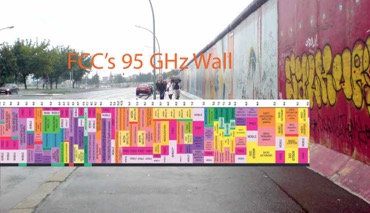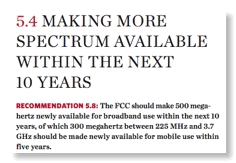Spectrum Frontiers Workshop:
Topics Covered and Avoided
Advanced wireless connectivity in highest spectrum bands on display at FCC Spectrum Frontiers workshop tomorrow https://t.co/idaohfNa68
— The FCC (@FCC) March 9, 2016
On March 10, 2016 FCC held a workshop entitled "Workshop and Tech Demonstration on Spectrum Frontiers and Technological Developments in the Millimeter Wave Bands". The original announcement clarified this a little by saying "exploring the concepts raised in the Commission’s Spectrum Frontiers NPRM and the state of technological developments in the millimeter wave (mmW) bands". The video of the workshop is now available on the FCC's website.
But while the "state of technological developments in the millimeter wave (mmW) bands" was promised, it reality only mobile 5G mmW technology was discussed along with some other 5G issues. Numerous times numerous speakers mentioned "500 MHz" - the goal for reallocation of spectrum to cellular at lower bands. There was't even any discussion of mmW-based backhaul for cellular with the implicit assumption that fiber would miraculously be available for high capacity mmW base stations. (While fiber is the cheapest medium for high bandwidth communications based on equipment costs and while FCC is pushing "dig once" policies, the reality is that fiber is not always everywhere. New fiber installation can be extremely expensive if the costs are not shared with other users or if needed quickly for base station installation. Indeed the term "self-backhaul" is used in Europe for the potential of doing some backhaul in the same band as mobile links was never even mentioned! (Self-backhaul would not be feasible in lower bands but is plausible due to the small wavelengths and high directionality of small antennas at mmW.)
But while "500 MHz" was an allowed diversion of the discussion, any use of spectrum above 71 GHz was not. Contact with several speakers revealed that they were urged to stick to the 5G agenda and not even mention any other topics. So while the mention of "500 MHz" and lower 5G bands was acceptable and the presence of Starry, Inc and FirstNet with totally unrelated topics was acceptable, any mention of fixed use - even for cellular backhaul and any mention of the FCC 95 GHz wall appears to have been verboten! Indeed, nothing was even mentioned above the 71 GHz limit in the Docket 14-177 NPRM. The last panel of federal speakers seemed to focus on either general issues or issues that related mainly to cellular spectrum under 6 GHz.

Present FCC rules have no provisions for licensed or unlicensed above 95 GHz and petitions for such move at a glacial pace while other countries subsidize such R&D
But as we have mentioned previously FCC's barrier to innovation at 95 GHz is quite real. The FCC's inaction on Battelle's RM-11713 102-109.5 GHz petition as well as the IEEE-USA request for a declaratory ruling (Docket 13-259) above on whether technology above 95 GHz is "new technology". (Not to mention the 2.5 years it took for FCC to untangle its apparently unintended wording in the revised Part 5 rules that forbid all experiments in passive bands (which are numerous in the mmW region) regardless of whether the nature of the experiment posed an actual interference threat to passive users.)
While we do not begrudge CTIA members access to mobile spectrum up to 71 GHz or even higher, does CTIA and its wishes like Donald Trump "suck all the oxygen out of the room"? We acknowledge that FCC has a spectrum policy productivity problem, but if that is the issue shouldn't FCC also acknowledge it and show what impact it is having on US competitiveness?
The basic reason why 5G mmW technology is even here now is that FCC took visionary action in 1995 in Docket 94-124 creating the first 60 GHz unlicensed band in the world and in 2003 in Docket 02-148 establishing the world's first 70/80/90 GHz bands just as it took action in 1985 creating the unlicensed ISM bands that are now home to Wi-Fi, Bluetooth and myriad other systems that have changed our world. When FCC took these three decisions they were not in response to major trade association like CTIA, indeed, some trade associations, including CEA/CTA's predecessor, actually opposed the 1985 decision.
It was because FCC stayed true to its original §303(g) mandate and had the confidence to prepare for the future — not spend all of its resources reacting to requests for instant gratification from powerful groups.
Status of IEEE-USA Petition at FCC
How Do You Count to 500?
On February 24, 2010 Chairman Genachowski announced in a speech at the New America Foundation:
“First, we are going to announce a gameplan to unleash more spectrum for mobile broadband. The National Broadband Plan will set a goal of freeing up 500 Megahertz of spectrum over the next decade. We will work closely with NTIA to do so.”
CTIA had previously stated
So the 500 MHz no doubt was a compromise number that attempted to address reality.“we need at least another 800 MHz within six years to meet the increasing consumer demand whether it's for mobile Internet, mHealth, smart grids, or a number of other wireless uses that change the way we live and work."

Traditionally the cellular industry has used full duplex symmetrically pair spectrum. Thus the cellular 800 MHz band is 824-849 MHz (mobile-to-base) paired with 869-894 MHz (base-to-mobile). The same type of symmetric pairing was used for PCS and 3G in high bands. This was clearly necessary when the predominant use of cellular was 2-way voice which has little tolerance of time latency/delay. But the rapid expansion of mobile communication volumes predicted by CTIA and the NBP are not 2 way voice, rather they are Internet and video related - categories that are asymmetric in information flows and more tolerant in time latency. Many of these flows are also highly intermittent as compared to voice, with high peak to average data rates. Is the traditional type of allocations the best way or the only way to handle this type of growth?
Your blogger has no objection to the reallocation of 500 MHz of spectrum for the traditional paired symmetric use, but it is becoming increasingly clear to all involved that finding 500 MHz of such spectrum will be in the extremely difficult to nearly impossible range. In addition, the major need for spectrum is in major metropolitan areas and the focus on nationwide availability of spectrum ignore options. From what I have heard, the cellular establishment wants FCC and NTIA to find it spectrum that has all the following characteristics:
- Nationwide full time availability
- Paired
- In large contiguous blocks
- Consistent with international allocations and international standards (note that this is not a legal requirement except near borders with Mexico and Canada absent a bilateral agreement)
So isn’t it time to start thinking of Plan B? If 500 MHz of spectrum meeting the cellular establishment’s 4 conditions can not be found with politically acceptable impact on other federal and nonfederal uses, how would “noncomplying” spectrum count towards the 500 MHz goal? Maybe for tactical reasons the cellular establish doesn’t want to consider this possibility, but to many of us it is a quite real possibility as none of the “spectrum haves” are anxious to release their part of the 500 MHz or have any impact from its altered use, e.g. GPS/LightSquared problem.
CBO knows how to “score” budget proposals, should FCC and NTIA start thinking about how to “score” spectrum reallocations with respect to the 500 MHz goal?
[I help my international neighbors by reading in English to their 4 year old. While I was writing this post, one of the books he selected was this one.I recommend it!]




![Validate my RSS feed [Valid RSS]](valid-rss-rogers.png)

